
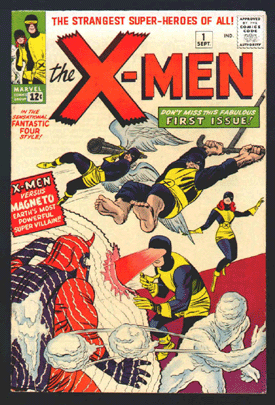 In Marvel’s recent history, there is perhaps no comic title that has been more influential or more important to the Marvel universe than X-Men.
In Marvel’s recent history, there is perhaps no comic title that has been more influential or more important to the Marvel universe than X-Men.
This is ironic, as there was a time when the X-Men series was on the verge of ending. Issues #67–93 were made entirely of reprints of the older issues, and it was only Len Wein, Dave Cockrum, and Chris Claremont’s timely re-introduction of the X-Men through the New X-Men, featured in 1975 in “Giant-Sized X-Men #1” and “X-Men #94,” that gave the X-Men a rebirth. This rebirth attained levels of popularity unseen before at Marvel and featured characters who would become some of the all-time favorites in the hallowed halls of X-Men-dom. Oh, and there was Cyclops, too . . . but we don’t talk about him.
While it would take a book, nay, multiple encyclopedia-sized volumes to write a comprehensive history of the X-Men, I’ll look at the X-characters over the next few articles (excluding next week’s), discuss their place in X-Men history, and look at how the cards reflect the characters.
The Birth of the X-Men
In September of 1963, a new team was born. They were known as the Avengers and featured several of the most popular Marvel characters at the time, including Iron Man, Ant-Man, Wasp, Thor, and the Hulk. Iron Man, Thor, and the Hulk essentially had their own books, and Ant-Man and the Wasp were frequent visitors.
While September of 1963 is primarily remembered for the Avengers, there was another birth during the same month—a brand-new team of never before seen characters who introduced the term “mutant” to the Marvel universe. The team was the X-Men, and they immediately made an impact. In their own comic, Angel, Beast, Cyclops, Iceman, and Marvel Girl led a different kind of fight.
The X-Men weren’t your ordinary superheroes; most heroes were either professional adventurers (like Captain America and Thor) or scientists and adventurers (like Mr. Fantastic, Ant-Man, and Iron Man). But Spider-Man had made waves, as he was a high school teen going through the same awkward growing pains that everyone does at that time. He was dealing with impending adulthood, school, and school-related issues like bullies, homework, and the sudden acknowledgement that there is another gender that’s not nearly as horrible as you thought it was a few years before.
But Peter Parker was still a geek—a science nut and an inventor (he created and designed his own costume, web shooters, webbing, and so on)—and that put him nicely in the same niche as Tony Stark and Hank Pym, even if he was younger.
Enter the X-Men. The X-Men were just a bunch of teenagers like any other teenager in the 60s. They were normal in every sense of the word, from fashion to what they desired from life. And they came from all walks of life. Angel was upper crust, Jean Grey was idle class, and Iceman was more of a small-town boy. Beast was brilliant intellectually, while Cyclops was a brilliant strategist and a strong leader who had a different kind of intelligence. Still, even Beast, who had the smarts, was charming and suave—the polar opposite of Peter Parker. Many issues had Beast and Iceman on a double date with a pair of local girls, and Beast never let his brains or his large body get in the way of his social life . . . even when he turned fuzzy and blue.
However, normal is not necessarily the best word to use, for these teenagers were Children of the Atom, a new breed of humanity that was just starting to make its appearance in the world. They had a genetic mutation that most humans didn’t have; unlike every other superhuman who had somehow gained powers or was granted powers, these were the first humans born with powers. They were gathered together by Professor X, a fellow mutant with designs toward creating a world that accepted people who were different. Charles Xavier ran Xavier’s School for Gifted Youngsters, at 1407 Graymalkin Lane in Salem Center, Westchester County, New York. 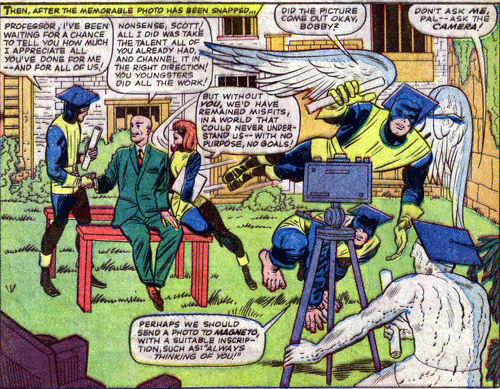
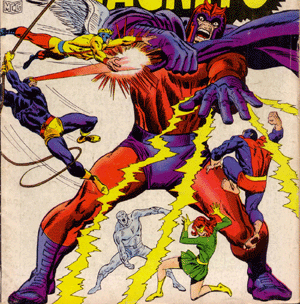 Xavier gathered these mutants together to help them learn to control their powers, and they were faced with an imminent threat to their existence—Magneto! An “evil” mutant who felt that mutants were the next step on the evolutionary chain and should therefore rule the Earth, his ideal was in direct conflict with Xavier’s. Magneto quickly formed a group of his own, The Brotherhood of Evil Mutants, and they and the X-Men would fight one another for decades.
Xavier gathered these mutants together to help them learn to control their powers, and they were faced with an imminent threat to their existence—Magneto! An “evil” mutant who felt that mutants were the next step on the evolutionary chain and should therefore rule the Earth, his ideal was in direct conflict with Xavier’s. Magneto quickly formed a group of his own, The Brotherhood of Evil Mutants, and they and the X-Men would fight one another for decades.
It became quickly apparent that the X-Men stood for more than the basic tenets of good versus evil and hero versus villain. Stan Lee and Jack Kirby, the original creators of the X-Men, began to explore many of the civil rights issues that were current in the United States and the rest of the world in the early 60s. The mutant X-Men stood in for every person who was oppressed because he or she was different. Mutants were viewed as dangerous, they were ostracized, and people were afraid of them. Unlike the celebrity Avengers and Fantastic Four, who were set upon for autographs and snapshots, the X-Men became outlaws, hiding from the public eye and, as often as not, blamed for the evil they worked so hard to prevent. And, with Magneto being a survivor of Auschwitz, there was always an underlying sense of the horror of what man is capable of doing to fellow man when they hate one another. Magneto stood as a symbol not only of that hate, but also of how being the recipient of hate could make someone equally capable of hatred. Magneto was more complex than the typical villain was; he was one of the first villains to have deep scars and layers of complexity beneath his veneer of insanity.
The First Five
Angel
Warren Kenneth Worthington III was born into privilege. His grandfather and father had built Worthington Industries into a billion dollar corporation. Warren inherited a massive amount of money when his parents died.
But he discovered his mutant abilities before then, back when he was a private school boy and his wings had begun to grow. He eventually left school and became a crime fighter in New York, calling himself the Avenging Angel. He was one of the last people contacted by Professor Xavier to join the original X-Men, and he fought with them until the second wave of X-Men joined up. Then, he left and went to Los Angeles, where he formed the Champions of Los Angeles along with the Iceman, Ghost Rider, Black Widow, and Hercules. He went from the Champions to the Defenders, and later he became one of the founding members of X-Factor, which was essentially a reunion of the original X-Men. 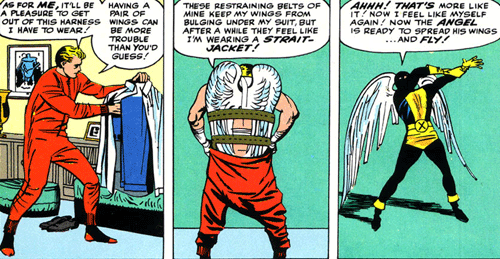
Then all hell broke loose during the era known as the Morlock Massacre (or Mutant Massacre), when a team of mercenaries hired by Mister Sinister went through the Morlock tunnels under New York City with the intention of cleansing the tunnels of all Morlock life. When the X-Men and X-Factor intervened, Angel was kidnapped by the Marauders, and Harpoon shot harpoons through his wings, pinning him to a wall. When infection set in, his wings were amputated, and under great duress and depression, Warren attempted to commit suicide by blowing up a plane he was flying.
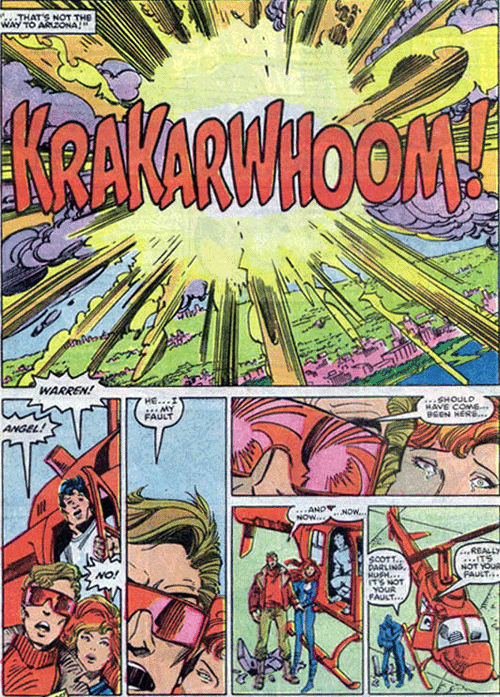
Rather than dying, however, he was saved by Apocalypse, who teleported Warren to his labs and genetically reconstructed his wings. He altered his DNA and his form; his skin became pale blue and his wings became metallic with razor-sharp feathers. Warren became Death, the Fourth Horseman of Apocalypse, and rode with the other Horsemen for a time. Eventually, he was convinced by Iceman (who had to fake his own death to do so) to abandon Apocalypse, and then he went off on his own, calling himself Archangel. He eventually rejoined the X-Men when he was able to come to terms with his new identity, and he recently underwent a “secondary mutation.”* His blood now has the power to heal, his skin has returned to pink, and his wings have become feathery once again. 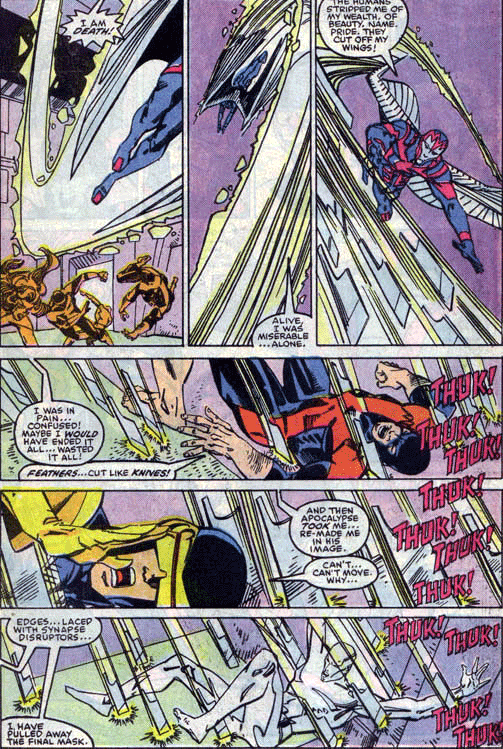
Archangel, Warren Worthington III, is his original, pre-Apocalypse form.** Ignore the costume featured on the card and look at the card itself. (Marvel Origins didn’t match the character images to the cards as well as the more recent sets have.) He is a younger Angel with lower stats, and his DEF is higher than his ATK. But his propensity to swoop down on unsuspecting support characters gives him an ATK bonus for the surprise factor.
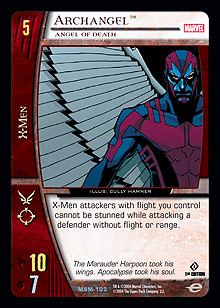 Archangel, Angel of Death is a different creature altogether. This Archangel is post-Apocalyptic (laugh at my clever pun!) and therefore has the razor-blade range. With the Horsemen swarm tactics engraved in his memory, he has a higher than average ATK, but a DEF that is one drop lower than average. He is a creature of attack and is about removing obstacles with little care for his own self. However, those razor feathers are vicious, and if you don’t have the flight to get out of the way, or the range to shoot them down, they’ll pin you to the wall and he’ll take you out without a scratch on his own genetically altered hide.
Archangel, Angel of Death is a different creature altogether. This Archangel is post-Apocalyptic (laugh at my clever pun!) and therefore has the razor-blade range. With the Horsemen swarm tactics engraved in his memory, he has a higher than average ATK, but a DEF that is one drop lower than average. He is a creature of attack and is about removing obstacles with little care for his own self. However, those razor feathers are vicious, and if you don’t have the flight to get out of the way, or the range to shoot them down, they’ll pin you to the wall and he’ll take you out without a scratch on his own genetically altered hide.
Beast
Henry McCoy was mutated at birth, a rare occurrence owing largely to the massive dose of radiation his father received during an incident at the nuclear power plant where he worked. As Henry grew up, his athletic prowess became increasingly apparent, and his aptitude as a football star garnered attention from Professor Xavier. After being helped by the X-Men to rescue his parents from the clutches of the evil Conquistador, he agreed to join them.
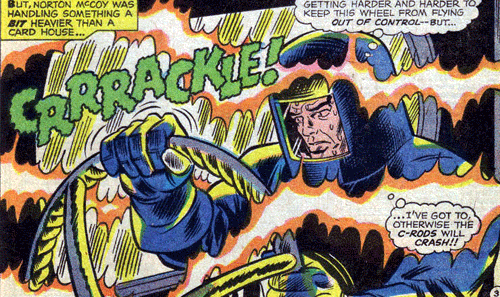
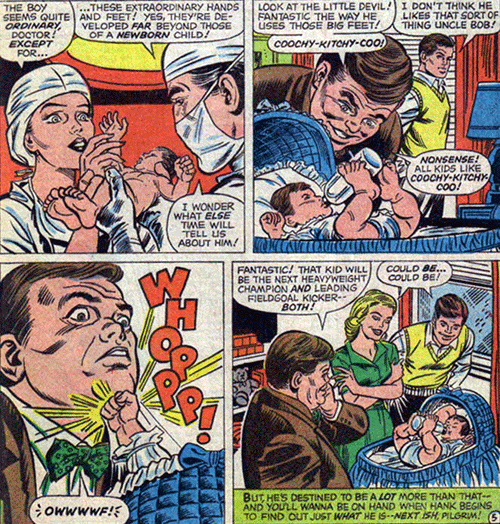
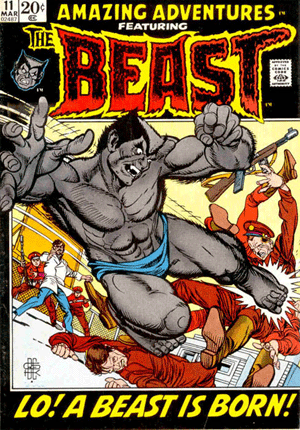 Xavier helped McCoy get his PhD. His aptitude wasn’t merely physical—his mind was as agile as his body. When the original X-Men broke apart, he left to join the Brand Corporation as a genetics researcher. It was there that he discovered a chemical that sped up the process of mutation and triggered latent mutations. Upon sampling the serum made from that chemical, he was physically altered into a literal beast. His body became covered with blue fur, his teeth became fangs, and his agility, speed, strength, and endurance increased. He became physically proportional in all ways to an animal.
Xavier helped McCoy get his PhD. His aptitude wasn’t merely physical—his mind was as agile as his body. When the original X-Men broke apart, he left to join the Brand Corporation as a genetics researcher. It was there that he discovered a chemical that sped up the process of mutation and triggered latent mutations. Upon sampling the serum made from that chemical, he was physically altered into a literal beast. His body became covered with blue fur, his teeth became fangs, and his agility, speed, strength, and endurance increased. He became physically proportional in all ways to an animal.
Dr. McCoy left Brand for the Avengers, where he made his identity public. He then re-formed the Defenders, bringing Angel and Iceman into the fold. When the Defenders disbanded, Beast joined his fellow original X-Men in X-Factor and was at one point reverted to his human form before ending up a fuzzy beast again. He returned to the X-Men, and he now serves on the Astonishing X-Men team with Cyclops, Emma Frost, Shadowcat, Colossus, and Wolverine. He also doubles as a researcher at the Xavier Institute.
Both versions of Beast (Beast, Dr. Henry McCoy and Beast, Furry Blue Scientist) look at the mind of Beast and not his physical prowess. While Beast could easily be a 4- or 5-drop on a card that celebrates his agility and off-the-wall combat techniques, we have one card, Dr. Henry McCoy, which shows off his keen mind and brilliant research—he discovered a way to make plot twists cheaper! The other card shows his sense of duty and belonging to the Avengers and the X-Men. He is always willing to help out former teammates by finding a Team-Up card to bring both teams together early on while the battle is still raring.
Cyclops
When Scott Summers was a young boy, he and his brother Alex were flying with their parents in a DeHaviland Mosquito, a wooden plane refurbished and flown by their father, US Air Force Major Christopher Summers, over the Pacific just off the coast of Alaska. Without warning, they were set upon by a Shi’ar warship on an exploratory mission to Earth, whose captain didn’t want the Shi’ar presence to be reported. With only one working parachute within easy reach, Scott’s mother put it on him, told him to keep hold of his brother, and pushed him out of the burning plane.
When the boys landed, they suffered multiple injuries. The landing put Scott into a coma and caused minor brain damage that affected little except the safeguards for his latent mutant power. Unfortunately, the damage didn’t remove the part of his brain that made him such an obnoxious twerp, but I digress.
His brother, who would eventually become Havok, was placed in an orphanage and later adopted. Scott wouldn’t see him again for a long time. Scott remained comatose for a year before eventually recovering and being placed in a different orphanage. Due to his brain damage, he wasn’t put up for adoption and stayed at the orphanage until he hit his mid-teens. It was at that point that Scott began to develop vicious migraines and visual problems. He went to get help from an eye specialist, who somehow discovered that glasses of ruby quartz alleviated his problems! (How he came to think of ruby quartz leads me to wonder what he was smoking, but I again digress . . .)
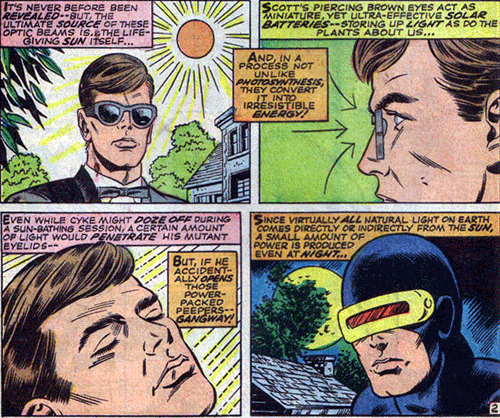

Scott was the second mutant to be discovered by Charles Xavier, who had been tutoring Jean Grey privately in the use of her powers for some time. Scott, who had already been reported to the FBI by his optometrist (who suspected him of being a mutant), proved his doctor correct by unwittingly firing off an uncontrolled optic blast into a large crane, knocking it over toward a crowd of gawking bystanders. Although he managed to destroy the crane before it harmed anyone, he was forced to flee the angry mob. He was working under the criminal who would become the Living Diamond when Xavier tracked him down and freed him from the criminal’s clutches. He accepted Xavier’s offer and joined the school, where he quickly showed his aptitude for leadership and became the team’s leader under the identity of Cyclops.
 Cyclops’s life was a rollercoaster of emotion. He was the only member to serve in every early incarnation of the X-Men—as leader, no less—and he watched firsthand as the love of his life, Jean Grey, became the Dark Phoenix and eventually killed herself in front of him. He married Madelyne Pryor, who was an unknowing clone of Jean Grey created by Mister Sinister. They had a child, Nathan, who would grow up to become Cable. In order to keep Scott at home and from the X-Men, she psionically affected a leadership challenge for the X-Men that caused Cyclops to lose to Storm. Storm ended up as the new leader of the X-Men while Scott temporarily retired to live with Madelyne and raise Nathan.
Cyclops’s life was a rollercoaster of emotion. He was the only member to serve in every early incarnation of the X-Men—as leader, no less—and he watched firsthand as the love of his life, Jean Grey, became the Dark Phoenix and eventually killed herself in front of him. He married Madelyne Pryor, who was an unknowing clone of Jean Grey created by Mister Sinister. They had a child, Nathan, who would grow up to become Cable. In order to keep Scott at home and from the X-Men, she psionically affected a leadership challenge for the X-Men that caused Cyclops to lose to Storm. Storm ended up as the new leader of the X-Men while Scott temporarily retired to live with Madelyne and raise Nathan.
Scott left Madelyne when he discovered that Jean was still alive, ending their marriage and helping to form X-Factor. After the events of Inferno, Madelyne died, and her death re-triggered the Phoenix Force in Jean’s mind. Scott and Jean married and began to raise Nathan as their own before sending him into the future to try to save him from a techno-virus. Cyclops would return to lead one of the X-teams, and Jean would die again, live again, and die again.
Scott eventually found solace in the arms of Emma Frost. He now runs the Xavier Institute with Emma and leads the Astonishing X-Men team.
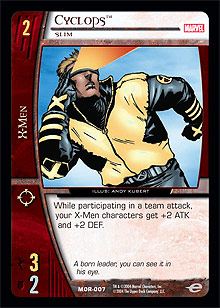 Cyclops’s two versions in the game really twig onto his leadership skills. His early drop, Cyclops, Slim, keys into the early days of the X-Men and the importance of teamwork. Note that although Cyclops is included in his ability, which rewards teamwork with an ATK bonus, he doesn’t have to be involved in the attack for the bonus to trigger. This is because Cyclops, as often as not, is in charge from the sidelines, ordering his soldiers into battle and focusing each of his team members’ abilities toward their best uses. Cable obviously inherited his keen leadership and strategic abilities from his father.
Cyclops’s two versions in the game really twig onto his leadership skills. His early drop, Cyclops, Slim, keys into the early days of the X-Men and the importance of teamwork. Note that although Cyclops is included in his ability, which rewards teamwork with an ATK bonus, he doesn’t have to be involved in the attack for the bonus to trigger. This is because Cyclops, as often as not, is in charge from the sidelines, ordering his soldiers into battle and focusing each of his team members’ abilities toward their best uses. Cable obviously inherited his keen leadership and strategic abilities from his father.
Cyclops’s 5-drop, Cyclops, Scott Summers, takes his leadership one step further. This version brings home the importance of supporting the attackers on the front. He rewards the characters who say in formation and attack from behind the powerhouses with a stun-free attack. His stats are a little below average, but they’re made up for with various tricks through X-Men locations and plot twists and his ability to risk an attack up the curve; even if the attack fails, he’ll be safely hidden where his target can’t touch him. This is another example of his leadership style—knowing how to use one’s environment in a battle; knowing when to take risks; and knowing when to sit around the corner, lying in wait.
Iceman
Robert “Bobby” Drake discovered his ability to create ice by freezing moisture in the air when he was entering puberty. He told his parents, who in turn told him to keep his special power under his hat for fear that the neighborhood would drive him out of town (or worse).
He was “outed” as a mutant during a date when he and his girlfriend were beset by local bullies. He froze the bully who was pulling his girlfriend away from him, and although the bully was completely unharmed, word spread quickly (as it does in smaller communities) and an angry mob rose up to get the mutant. They invaded the Drake household, and Bobby tried to hold them off with his power but was overwhelmed. It took a levelheaded sheriff to save Bobby from the horde, and he was taken into protective custody.

Cyclops, the first X-Man, arrived in town to help Bobby at Professor Xavier’s behest. He broke into the jail to free Bobby, but Bobby refused his help, sparking a fight between them. They ended up in the streets, where they were both captured by the now unruly mob, who wished to lynch the two mutants. Only the timely intervention of Professor X and his powerful psychic abilities saved them. The Drake family agreed to let Bobby go to the school and willingly allowed Professor X to wipe their minds clean of the knowledge of Bobby’s powers. Bobby went to Xavier’s School, where he became Iceman, the second official X-Man.
He fought alongside the X-Men until the original team disbanded, at which point he joined Angel in the Champions, and then later joined the Defenders with Angel and Beast. When they disbanded, Bobby tried his hand as an accountant, but he quickly became dissatisfied with that job and joined his fellow original X-Men in X-Factor.
He eventually rejoined the X-Men and learned to use his powers to a greater degree. At one point, his powers spiraled nearly out of control and he had to wear a special belt to keep him from freezing everything around him.
Bobby is essentially a clown and a hotshot, almost like a cold version of the Human Torch. But in recent years, his goofiness dried up a bit with after some traumatic experiences. He was possessed by a previously comatose Emma Frost, who pushed his powers to the limit before regaining her own body. He had a rollercoaster relationship with his girlfriend Opal and a simultaneous rift with his father who hated mutants and rediscovered that Bobby was one of them. He had to deal with the near-death of his father and a difficult reconciliation. He had feelings for Polaris that he’d harbored since their relationship together, way back in the early days of the X-Men, but had to watch as she built a relationship with Havok that eventually led to near-marriage. After all that, his clowning and humor turned into sniping and bitterness more often than not.
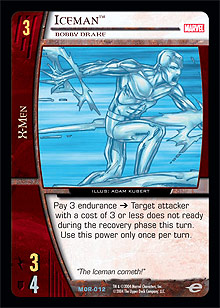 The two versions of Iceman show his different levels of power and the different sides to his personality. Iceman, Bobby Drake is the early Iceman who was learning to control his powers, and although he was a clown even then, he wasn’t filled with the overconfidence from which he would later suffer. He doesn’t have range, as his early days consisted of him being able to travel on ice-slides and freeze people—he wasn’t up to par with the ice balls yet. His ability reflects his freezing power, essentially freezing a target of similar strength (characters who were more powerful could break the ice) for a turn while the target tried to extricate him or herself from the frozen prison. “Cannot ready” became synonymous with freezing abilities early in Vs. System, and other characters, such as Mr. Freeze, have similar abilities.
The two versions of Iceman show his different levels of power and the different sides to his personality. Iceman, Bobby Drake is the early Iceman who was learning to control his powers, and although he was a clown even then, he wasn’t filled with the overconfidence from which he would later suffer. He doesn’t have range, as his early days consisted of him being able to travel on ice-slides and freeze people—he wasn’t up to par with the ice balls yet. His ability reflects his freezing power, essentially freezing a target of similar strength (characters who were more powerful could break the ice) for a turn while the target tried to extricate him or herself from the frozen prison. “Cannot ready” became synonymous with freezing abilities early in Vs. System, and other characters, such as Mr. Freeze, have similar abilities.
Iceman’s Spider-Friends version, a throwback to everyone’s favorite 80’s cartoon, shows Iceman at his clowniest. Cocky and overconfident, this Iceman has higher stats and range (he perfected the ice blast), and his ice power is so strong that he literally freezes the battlefield to eliminate potential threats; his ability to force an opponent to discard cards symbolizes the threats that are removed by mass freezing.
Jean Grey
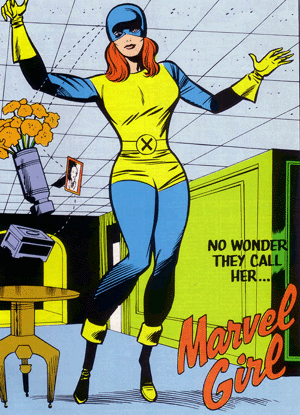 Jean Grey’s history is very complex and convoluted. This is reflective of Jean Grey herself, who was an old woman since she was a little child and was forced to grow up ahead of her time.
Jean Grey’s history is very complex and convoluted. This is reflective of Jean Grey herself, who was an old woman since she was a little child and was forced to grow up ahead of her time.
Her powers made themselves known when her best friend, as a ten-year-old girl, was hit by a car. This unleashed Jean’s mutant power and she felt the pain, mental anguish, and trauma her friend Annie felt as she lay dying. It stayed with Jean and she needed therapy, both emotional and psychical, to stop herself from going insane. Jean never truly got over it.
Xavier took Jean in when she was eleven and taught her how to use and control her powers. She became the fifth and final X-(wo)Man, though one could argue that she was the first, as Xavier had been working with her for years before he took Cyclops into his new school. Jean became Marvel Girl and was invaluable to the team—an anchor that kept the testosterone down and held them together through rough patches. She was like a daughter to Xavier, closer to him than the others, very possibly because of the similar nature of their powers and his long-standing relationship with her. Eventually, she and Scott Summers fell in love, and that love changed them inside and out.
When the original X-Men split up, only Cyclops remained behind to lead the new X-Men. His and Jean’s relationship remained intact, even though she wasn’t a teammate. And this is where her history gets tricky.
Very basically, she volunteered to pilot an unsafe shuttle back to Earth, succumbed to radiation poisoning, and “died.” At the same time, her essence was bonded with a primordial cosmic force called the Phoenix Force. The Phoenix Force supposedly saved her life and placed her comatose body into a rehabilitation pod at the bottom of Jamaica Bay. In the meantime, the Phoenix Force recreated Jean’s body and became Jean Grey to the other X-Men, posing as Jean and calling herself Phoenix. However, imitation is more than just the sincerest form of flattery, and the Phoenix began truly to think of herself as Jean Grey. The power of the Phoenix Force was too much for a humble creature like Jean Grey to wield, and even though Professor X put mental blocks in her mind to prevent her from losing control, the mental meddling of Mastermind wiped those blocks away and Phoenix became Dark Phoenix. Dark Phoenix fed on stars and wielded enough power to devastate the universe. 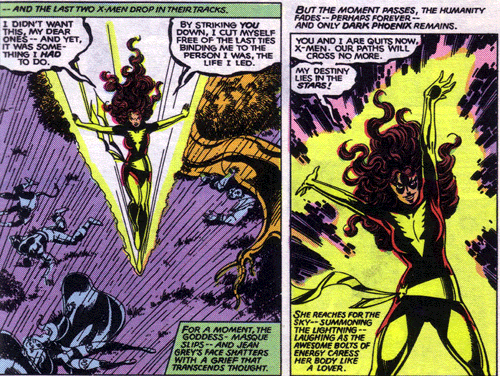
Eventually, Phoenix’s Jean Grey state reasserted itself and she committed suicide—as Jean would have done—to prevent herself from falling victim to her dark side again. Soon after, Jean’s body was discovered by the Avengers and the Fantastic Four, and she slowly began to recall what had happened to her. She also lost her telepathic powers, though she retained her telekinetic powers. She joined her fellow original X-Men in X-Factor, and then in the X-Men again. She would be responsible for Madelyne Pryor’s death and would eventually marry Scott Summers and again take the name of Phoenix.
Jean eventually regained her full powers and slowly began to tap into the Phoenix Force again. But while her powers were getting on splendidly, her marriage wasn’t. Cyclops was having an affair with Emma Frost, and Jean discovered it the hard way by walking in on them. Eventually, Magneto would end up killing her. She died in Scott’s arms, forgiving him with her final words.
But, surprise, surprise, she was resurrected again! Multiple times! And we also discover that there never really was a separation between Phoenix and Jean Grey. Jean is more like a human avatar of a cosmic force. Although the Phoenix Force has had other hosts, Jean has a bond with it beyond that of any other host. At this moment in the Marvel continuity, she is officially dead, though the Force is strong in her not-quite-daughter, Rachel Summers, the new Marvel Girl. And Jean’s spirit has transcended, so we’re just as likely to see her return in some future storyline as not.
There are two versions of Jean Grey in the game. Dark Phoenix is a third, but even though they are intrinsically connected, the Phoenix Force is enough of an individual entity (for lack of a better word) that when she was the Dark Phoenix, there was no aspect of Jean in her, doppelganger or real.
Jean Grey, Marvel Girl is the young and impressionable Jean Grey, still learning how to use her powers and getting used to her role as an X-(wo)Man. A higher than average DEF reflects the defensive side of her powers. Her ability is to replace a resource you control—to use her combination of telepathy and telekinesis to decide what resource is no longer useful and replace it with something that potentially is. Her ability is not strong enough to guarantee success, but it is strong enough to set the wheels in motion.
 Jean Grey, Phoenix Force is the Phoenix entity modeling itself after Jean Grey and it displays the bond between the Jean Grey essence and the Phoenix essence. As a lovely translation of comic flavor into game effect, you need to have Jean Grey in the KO’d pile to recruit Phoenix Force, as Jean Grey was in a coma under the sea while Phoenix was playing Jean Grey in the X-Men. Her ability is reflective of the awesome level of power that the Phoenix Force provides, but also of the restraint of the Phoenix when Jean’s essence was dominant in her psyche. She doesn’t KO or stun the characters; she returns them to their controller’s hand, which is more humane. Rather than taking them out, she simply sends them packing. Dark Phoenix is the character that succumbs to the dark side. She literally uses her awesome power to feed on resources, causing the very stars to collapse and turn into black holes when she’s sucked them dry. Dark Phoenix KO’s all resources. She doesn’t send them carefully packing; she callously destroys life to sustain herself.
Jean Grey, Phoenix Force is the Phoenix entity modeling itself after Jean Grey and it displays the bond between the Jean Grey essence and the Phoenix essence. As a lovely translation of comic flavor into game effect, you need to have Jean Grey in the KO’d pile to recruit Phoenix Force, as Jean Grey was in a coma under the sea while Phoenix was playing Jean Grey in the X-Men. Her ability is reflective of the awesome level of power that the Phoenix Force provides, but also of the restraint of the Phoenix when Jean’s essence was dominant in her psyche. She doesn’t KO or stun the characters; she returns them to their controller’s hand, which is more humane. Rather than taking them out, she simply sends them packing. Dark Phoenix is the character that succumbs to the dark side. She literally uses her awesome power to feed on resources, causing the very stars to collapse and turn into black holes when she’s sucked them dry. Dark Phoenix KO’s all resources. She doesn’t send them carefully packing; she callously destroys life to sustain herself.
Next Week: Justice League of America previews awaaaaaaaaaaaaaaaay!
Questions? Queries? Comments? Send ’em along and I’ll try to get them answered in the column! Email me at Kergillian (at) hotmail (dot) com.
* Some have argued that these “secondary mutations” are not truly new mutations but an extension of their original powers. Personally, I don’t care either way, but it is a new power.
** It’s unfortunate that UDE only came up with the brilliant idea of identities during DC Origins, as there are so many characters in Marvel Origins that should have them. Many, including myself, speculated way back during the days of Marvel Origins about how they would reconcile characters with different names or several people who masqueraded as the same character, and identities were and ingenious response! However, it makes it difficult to fix Archangel, Shadowcat, Ant-Man, Frankie Raye, and several others whose names make it difficult to deal with alternate identities, or in the case of Scott Lang and Frankie Raye, other characters with their “hero” identities.
Also known by his screen name Kergillian, Ben Kalman has been involved in the Vs. community since day one. He started the first major online community, the Vs. Listserv, through Yahoo! Groups, and it now boasts well over 1,750 members! For more on the Yahoo! group, go to http://groups.yahoo.com/group/Marvel_DC_TCG.